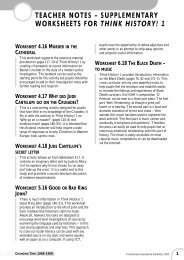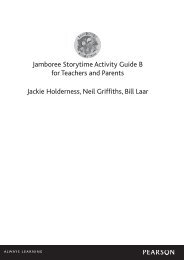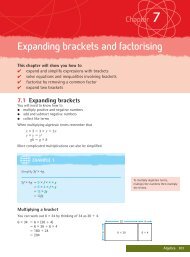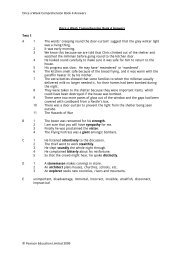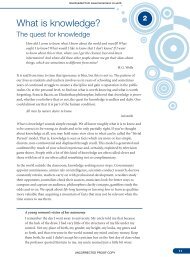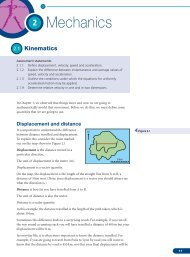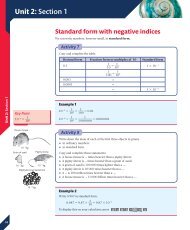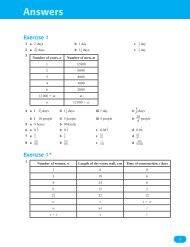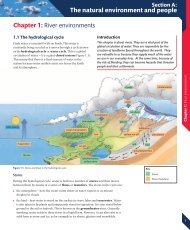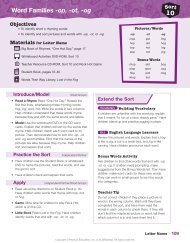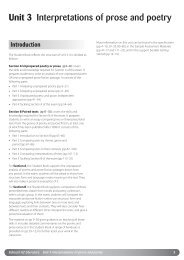Resource Sampler - Pearson
Resource Sampler - Pearson
Resource Sampler - Pearson
You also want an ePaper? Increase the reach of your titles
YUMPU automatically turns print PDFs into web optimized ePapers that Google loves.
Teacher <strong>Resource</strong> <strong>Sampler</strong><br />
Algebra 1<br />
Common Core
Going beyond the textbook with<br />
<strong>Pearson</strong> Algebra 1 Common Core Edition provides the teacher with a wealth<br />
of resources to meet the needs of a diverse classroom. From extra practice, to<br />
performance tasks, to activities, games, and puzzles, <strong>Pearson</strong> is your one-stop<br />
shop for all Common Core teaching resources.<br />
The wealth and flexibility of resources will enable you to easily adapt to your<br />
classroom’s changing needs. This sampler takes one lesson from Algebra 1 and<br />
highlights the support available for that lesson and chapter, illustrating the scope<br />
of resources available for the program as a whole, and how they can help you<br />
help your students achieve algebra success!<br />
Inside this sampler you will find:<br />
■ rigorous practice worksheets<br />
■ extension activities<br />
■ intervention and re-teaching resources<br />
■ support for English Language Learners<br />
■ leveled assessments<br />
■ activities and projects<br />
■ standardized test prep<br />
■ additional problems for teaching each lesson<br />
Log On and Learn<br />
Introducing PowerAlgebra.com and<br />
PowerGeometry.com—the gateway<br />
for students and teachers to all the<br />
digital components available for the<br />
series. Go to PowerAlgebra.com<br />
or PowerGeometry.com and fill in<br />
the information below.<br />
User Name: CommonCore2012*<br />
Password: pearsonmath<br />
* Type is case sensitive<br />
2
<strong>Pearson</strong> Algebra 1<br />
Contents<br />
Student Companion 4<br />
Think About a Plan 8<br />
Practice G 9<br />
Practice K 11<br />
Standardized Test Prep 13<br />
Solve It and Lesson Quiz 14<br />
Additional Problems 15<br />
Reteaching 17<br />
Additional Vocabulary Support 19<br />
Activity 20<br />
Game 21<br />
Puzzle 22<br />
Enrichment 23<br />
Teaching with TI Technology 24<br />
Chapter Quiz 26<br />
Chapter Test 28<br />
Find the Errors! 30<br />
Performance Tasks 33<br />
Extra Practice 35<br />
Chapter Project 39<br />
Cumulative Review 41<br />
3
5-4<br />
Point-Slope Form<br />
Vocabulary<br />
Review<br />
1. Circle the equation that has a y-intercept of 3.<br />
y 5 3x 1 4 y 5 4x 2 3 y 5 5x 1 3 y 523x 1 2<br />
2. Circle the equation that is in slope-intercept form.<br />
2x 2 y 5 10 x 1 3y 1 11 5 0 y 2 4 5 2 3<br />
(x 1 7) y 5 2x 1 6<br />
3. Circle the statement that is true about the y-intercept of any graph.<br />
occurs where y 5 0 occurs where x 5 0 occurs where graph<br />
on the graph on the graph touches the x-axis<br />
Vocabulary Builder<br />
function (noun) FUNGK shun<br />
Input<br />
Function Rule<br />
Related Words: input, output, function rule<br />
Definition: A function is a relationship that assigns exactly<br />
one output value to each input value.<br />
Main Idea: A function is used to describe how one value depends on another.<br />
Example: The function machine above shows that the function assigns an output to<br />
every input according to a specified rule.<br />
Use Your Vocabulary<br />
Complete each sentence with the appropriate word from the list.<br />
price sun time<br />
4. The length of a shadow is a function of the angle of the 9.<br />
5. The amount of water that has leaked from a leaky faucet is a function of 9.<br />
6. The amount of sales tax you pay is a function of the item’s 9.<br />
Output<br />
Copyright © by <strong>Pearson</strong> Education, Inc. or its affiliates. All Rights Reserved.<br />
Chapter<br />
4<br />
5 150<br />
For review purposes only. Not for sale or resale.
Key Concept Point-Slope Form of a Linear Equation<br />
The point-slope form of an equation of a nonvertical line with slope m and through<br />
point (x 1 , y 1 ) is y 2 y 1 5 m(x 2 x 1 ).<br />
7. In the above, what does (x 1 , y 1 ) represent? 8. What does m represent?<br />
Problem 1<br />
Writing an Equation in Point-Slope Form<br />
Got It? A line passes through (8, 24) and has slope 2 3 . What is an equation in<br />
point-slope form of the line?<br />
9. Use the point-slope form of an equation. For a line that passes through (8, 24) and<br />
has slope 2 3 , circle x 1 and underline y 1 .<br />
2<br />
24<br />
3 8 12<br />
10. Now substitute into point-slope form.<br />
y y 1 m (x x 1 )<br />
y (x )<br />
11. An equation of the line is .<br />
Copyright © by <strong>Pearson</strong> Education, Inc. or its affiliates. All Rights Reserved.<br />
Problem 2<br />
Graphing Using Point-Slope Form<br />
Got It? What is the graph of the equation y 1 7 52 4 5 (x 2 4)?<br />
12. Circle the ordered pair of a point on the graph of y 1 7 52 4 5 (x 2 4).<br />
(7, 4) (4, 7) (24, 27) (4, 27)<br />
13. Circle the correct description of the slope.<br />
Go up 4 units and left 5 units Go down 4 units and left 5 units Go up 4 units and right 5 units<br />
14. Use your answers to Exercises 12 and 13<br />
y<br />
to graph the line.<br />
8<br />
6<br />
10 8<br />
6<br />
4<br />
2<br />
x<br />
4 2 O 2 4 6 8 10<br />
2<br />
4<br />
6<br />
8<br />
For review purposes only. Not for sale or resale.<br />
151 Lesson 5-4<br />
5
Problem 3<br />
Using Two Points to Write an Equation<br />
Got It? Use the point (22, 23) to write an equation of the line shown.<br />
15. Follow the steps to write the equation of the line shown.<br />
1<br />
Find the slope of the line. Use two points and the<br />
y 2 y 1<br />
slope formula, m =<br />
x 2 x<br />
. 1<br />
4<br />
2<br />
(2, 3)<br />
4<br />
2<br />
y<br />
x<br />
O 2 4<br />
2<br />
4<br />
(1, 4)<br />
2<br />
Use the slope and the point (2, 3) to write<br />
an equation of the line in point-slope form.<br />
y y 1 m(x x 1 )<br />
y (x )<br />
An equation of the line is .<br />
Problem 4<br />
Using a Table to Write an Equation<br />
Got It? The table shows the number of gallons of water y<br />
in a tank after x hours. The relationship is linear. What is an<br />
equation in point-slope form that models the data? What<br />
does the slope represent?<br />
16. Complete the reasoning model below.<br />
Think<br />
I can use any two points from the table to find<br />
the slope.<br />
Then I can substitute one point and the slope<br />
into the point-slope equation.<br />
Finally, I can tell what the slope represents.<br />
m <br />
4570 <br />
3 <br />
Volume of Water in Tank<br />
Write<br />
Time, x<br />
(h)<br />
2<br />
3<br />
5<br />
8<br />
<br />
y y 1 m (x x 1 )<br />
y (x )<br />
The slope represents a rate of ? .<br />
Water, y<br />
(gal)<br />
3320<br />
4570<br />
7070<br />
10,820<br />
Copyright © by <strong>Pearson</strong> Education, Inc. or its affiliates. All Rights Reserved.<br />
6<br />
Chapter 5 152<br />
For review purposes only. Not for sale or resale.
Got It? Reasoning Write the equation from Exercise 16 in slope-intercept form.<br />
What does the y-intercept represent?<br />
17. Write the equation in point-slope form from Exercise 16. Use it to write the<br />
equation in slope-intercept form.<br />
18. What does the y-intercept in your answer to Exercise 17 represent?<br />
_______________________________________________________________________<br />
_______________________________________________________________________<br />
Lesson Check<br />
• Do you UNDERSTAND?<br />
Reasoning Can any equation in point-slope form also be written in<br />
slope-intercept form? Give an example to explain.<br />
19. Use point-slope form, y 2 y 1 5 m(x 2 x 1 ), and any point and slope to<br />
write an equation in point-slope form.<br />
20. Now write your equation in slope-intercept form.<br />
Copyright © by <strong>Pearson</strong> Education, Inc. or its affiliates. All Rights Reserved.<br />
21. Can any equation in point-slope form also be written in slope-intercept form? Yes / No<br />
Math Success<br />
Check off the vocabulary words that you understand.<br />
point-slope form equation graph<br />
Rate how well you can write equations in point-slope form.<br />
Need to<br />
review<br />
0 2 4 6 8 10<br />
Now I<br />
get it!<br />
For review purposes only. Not for sale or resale.<br />
153 Lesson 5-4<br />
7
Name Class Date<br />
5-4<br />
Think About a Plan<br />
Point-Slope Form<br />
Boiling Point The relationship between altitude and the boiling point of water is linear.<br />
When the altitude is 8000 ft, water boils at 197.6°F. When the altitude is 4500 ft, water<br />
boils at 203.9°F. Write an equation giving the boiling point b of water (in degrees<br />
Fahrenheit) in terms of the altitude a (in feet). What is the boiling point of water at 2500<br />
ft?<br />
Understanding the Problem<br />
1. What are you given?<br />
__________________________________________________________________________<br />
2. In general, how can this information be used to answer the question?<br />
__________________________________________________________________________<br />
Planning the Solution<br />
3. What is the slope formula?<br />
__________________________________________________________________________<br />
4. Substitute given values into the slope formula and simplify. Show your work.<br />
__________________________________________________________________________<br />
5. Which point can be used to write the point-slope form of the equation?<br />
__________________________________________________________________________<br />
6. What strategy can you use to solve this problem?<br />
__________________________________________________________________________<br />
7. How can you determine the boiling point of water at 2500 ft?<br />
__________________________________________________________________________<br />
Getting an Answer<br />
8. Write an equation giving the boiling point b of water (in degrees Fahrenheit) in<br />
terms of the altitude a.<br />
9. What is the boiling point of water at 2500 ft? Show your work.<br />
8<br />
Prentice Hall Algebra 1 • Teaching <strong>Resource</strong>s<br />
Copyright © by <strong>Pearson</strong> Education, Inc., or its affiliates. All Rights Reserved.<br />
32<br />
For review purposes only. Not for sale or resale.
Name Class Date<br />
5-4 Practice Form G<br />
Point-Slope Form<br />
Write an equation of the line in slope-intercept form through the given point and with the<br />
given slope m.<br />
1. (2, 1); m = 3 2. (–3, –5); m = –2<br />
3. (−4, 11); m= 3 2<br />
4. (0, −3); m = −<br />
4<br />
3<br />
Graph each equation.<br />
5. y − 2 = 2(x + 3) 6. y + 3 = –2(x + 1) 7.<br />
Write an equation in point-slope form for each line.<br />
8. 9. 10.<br />
Write an equation in point-slope form of the line through the given points. Then<br />
write the equation in slope-intercept form.<br />
11. (4, 0), (−2, 1) 12. (−3, −2), (5, 3) 13. (−5, 1), (3, 4)<br />
1<br />
14. Open-Ended Write an equation of a line that has a slope of − in each form.<br />
2<br />
a. point-slope form b. slope-intercept form<br />
Prentice Hall Gold Algebra 1 • Teaching <strong>Resource</strong>s<br />
Copyright © by <strong>Pearson</strong> Education, Inc., or its affiliates. All Rights Reserved.<br />
33<br />
For review purposes only. Not for sale or resale.<br />
9
Name Class Date<br />
5-4<br />
Practice (continued) Form G<br />
Point-Slope Form<br />
Model the data in each table with a linear equation in slope-intercept form.<br />
What do the slope and y-intercept represent?<br />
15. 16.<br />
Graph the line that passes through the given point and has the given slope m.<br />
17. (−3, −4); m = 6 18. (−2, 1), m = −3 19. (−4, −2);<br />
1<br />
m =<br />
2<br />
20. Writing Describe what you know about the graph of a line represented by the<br />
equation<br />
21. Writing Describe how you would use the point-slope form to write the<br />
equation of a line that passes through the points (−1, 4) and (−3, −5) in<br />
slope-intercept form.<br />
22. Writing Describe how linear data given in a table can help you write an<br />
equation of a line in slope-intercept form.<br />
23. A sign says that 3 tickets cost $22.50 and that 7 tickets cost $52.50.<br />
Write an equation in point-slope form that represents the cost of<br />
tickets. What is the graph of the equation?<br />
Prentice Hall Gold Algebra 1 • Teaching <strong>Resource</strong>s<br />
Copyright © by <strong>Pearson</strong> Education, Inc., or its affiliates. All Rights Reserved.<br />
34<br />
10<br />
For review purposes only. Not for sale or resale.
Name Class Date<br />
5-4 Practice Form K<br />
Point-Slope Form<br />
Write an equation in point-slope form of the line that passes through the given<br />
point and has the given slope.<br />
1. (1, 3); m = 5 2. (–2, –1); m = –3<br />
3. (4, –7); m = −<br />
1 4<br />
Graph each equation.<br />
4. y + 1 = 3(x – 2) 5. y – 4 = –1(x + 2) 6. y – 3 = –2(x + 4)<br />
Graph the line that passes through the given point and has the given slope m.<br />
7. (–1, –3); m = 2 8. (–3, –2); m = –4<br />
9. (–2, 6); m = −<br />
1 2<br />
10. Open-Ended Write an equation in each of the following forms that has a<br />
2<br />
slope of −<br />
3<br />
a. point-slope form b. slope-intercept form<br />
11. Writing Describe what you know about the graph of a line represented by the<br />
equation y + 4 = –5(x – 1).<br />
For review purposes only. Not for sale or resale.<br />
Prentice Hall Foundations Algebra 1 • Teaching <strong>Resource</strong>s<br />
Copyright © by <strong>Pearson</strong> Education, Inc., or its affiliates. All Rights Reserved.<br />
35<br />
11
Name Class Date<br />
5-4<br />
Practice (continued) Form K<br />
Point-Slope Form<br />
Model the data in each table with a linear equation in slope-intercept form.<br />
What do the slope and y-intercept represent?<br />
12.<br />
13.<br />
Write an equation in point-slope form of each line.<br />
14. 15.<br />
Write an equation in point-slope form of the line that passes through the given points.<br />
Then write the equation in slope-intercept form.<br />
16. (5, 1), (0, 2) 17. (–2, –3), (4, 3)<br />
18. (–3, –2), (2, 3) 19. (2, 5), (8, –7)<br />
20. Writing Describe how you would use the point-slope form to write the<br />
equation of a line that passes through the points (2, 3) and (–1, 6) in slopeintercept<br />
form.<br />
21. A restaurant’s goal is to serve 600 customers in 8 hours and 900<br />
customers in 12 hours. Write an equation in point-slope form that<br />
represents the number of customers served per hour. What is the<br />
graph of the equation?<br />
Prentice Hall Foundations Algebra 1 • Teaching <strong>Resource</strong>s<br />
Copyright © by <strong>Pearson</strong> Education, Inc., or its affiliates. All Rights Reserved.<br />
36<br />
12<br />
For review purposes only. Not for sale or resale.
Name Class Date<br />
5-4<br />
Standardized Test Prep<br />
Point-Slope Form<br />
Multiple Choice<br />
For Exercises 1–5, choose the correct letter.<br />
1. Which equation is equivalent to y 2 6 5212(x 1 4)?<br />
A. y 526x 2 48 C. y 5212x 2 42<br />
B. y 5 6x 2 48 D. y 5212x 2 54<br />
2. Which point is located on the line represented by the equation<br />
y 1 4 525(x 2 3)?<br />
F. (24, 25) G. (25, 24) H. (3, 24) I. (23, 4)<br />
3. Which equation represents the line that passes through the points (6, 23)and<br />
(24, 29)?<br />
A. y 1 4 52 3 5 (x 1 9) C. y 2 3 5 3 5<br />
(x 1 6)<br />
B. y 1 4 5 5 3 (x 1 9) D. y 1 3 5 3 5<br />
(x 2 6)<br />
4. Which equation represents the line shown in the graph?<br />
F. y 523x 2 2<br />
G. y 5 3x 1 2<br />
H. y 1 4 523(x 2 2)<br />
I. y 1 8 523(x 2 2)<br />
5. The population of a city increases by 4000 people each year. In<br />
2025, the population is projected to be 450,000 people. What is<br />
an equation that gives the city’s population p (in thousands of<br />
people) x years after 2010?<br />
A. p 5 4x 1 450 C. p 2 15 5 4(x 2 450)<br />
B. p 2 450 5 4(x 2 5) D. p 5 4x 1 15<br />
8<br />
4<br />
x<br />
8 4 O 4 8<br />
4<br />
8<br />
y<br />
Short Response<br />
6. The table shows the cost of a large cheese pizza with<br />
additional toppings on it.<br />
a. What is an equation in point-slope form that represents<br />
the relationship between the number of toppings and the<br />
cost of the pizza?<br />
b. What is the graph of the equation?<br />
Toppings<br />
2<br />
3<br />
5<br />
Cost ($)<br />
10.50<br />
11.75<br />
14.25<br />
Prentice Hall Algebra 1 • Teaching <strong>Resource</strong>s<br />
Copyright © by <strong>Pearson</strong> Education, Inc., or its affiliates. All Rights Reserved.<br />
37<br />
For review purposes only. Not for sale or resale.<br />
13
5-4 Solve It!<br />
Can you always use<br />
slope-intercept<br />
form? Try it here,<br />
and then learn an<br />
easier way in the<br />
lesson.<br />
The red line shows the altitude of a hot-air balloon during its linear<br />
descent. What is an equation of the line in slope-intercept form? (Hint:<br />
What is the altitude of the balloon when it starts its descent at x 5 0 ?)<br />
y<br />
Altitude (meters)<br />
680<br />
640<br />
600<br />
560<br />
520<br />
(5, 640)<br />
(15, 620)<br />
(35, 580)<br />
(45, 560)<br />
namic Activity<br />
nt-Slope Form<br />
a Line<br />
0 10 20 30 40 50<br />
Time (seconds)<br />
x<br />
5-4 Lesson Quiz<br />
1. Do you UNDERSTAND? A line passes through (22, 5) and has<br />
slope 1 3<br />
. What is an equation of the line in point-slope form?<br />
2. What is the graph of the equation y 1 3 5 2(x 1 3)?<br />
3. What is an equation in point-slope form of<br />
the line shown below?<br />
4<br />
(4, 1)<br />
y<br />
4<br />
2<br />
2 O 2<br />
2<br />
4<br />
x<br />
4<br />
(4, 3)<br />
Answers<br />
Solve It!<br />
y 522x 1 650<br />
Lesson Quiz<br />
1. y 2 5 5 1 (x 1 2)<br />
3<br />
2.<br />
y<br />
4<br />
1<br />
3. y 2 1 52 (x 1 4) or<br />
2<br />
1<br />
y 1 3 52 (x 2 4)<br />
2<br />
4<br />
2 O 2<br />
2<br />
4<br />
x<br />
4<br />
14<br />
Prentice Hall Algebra 1 • Solve It/Lesson Quiz on Transparencies<br />
Copyright © by <strong>Pearson</strong> Education, Inc., or its affiliates. All Rights Reserved.<br />
38<br />
For review purposes only. Not for sale or resale.
Name Class Date<br />
5-4<br />
Additional Problems<br />
Point-Slope Form<br />
Problem 1<br />
A line passes through (1, 24) and has slope 3. What is an<br />
equation of the line in point-slope form?<br />
Problem 2<br />
What is the graph of the equation y 1 3 522(x 2 2)?<br />
Prentice Hall Algebra 1 • Additional Problems<br />
Copyright © by <strong>Pearson</strong> Education, Inc., or its affiliates. All Rights Reserved.<br />
75<br />
For review purposes only. Not for sale or resale.<br />
15
Name Class Date<br />
5-4<br />
Additional Problems (continued)<br />
Point-Slope Form<br />
Problem 3<br />
What is an equation in point-slope form of the line shown<br />
below?<br />
y<br />
4<br />
(4, 4)<br />
(2, 1)<br />
x<br />
4 2 O 2 4<br />
2<br />
4<br />
Problem 4<br />
The table shows the amount of time Julio works and his<br />
total wages. What equation in slope-intercept form gives<br />
Julio’s wages at any time? What do the slope and y-intercept<br />
represent?<br />
Julio’s Earnings<br />
Hours<br />
Worked<br />
5<br />
10<br />
15<br />
20<br />
Wages<br />
$130<br />
$210<br />
$290<br />
$370<br />
16<br />
Prentice Hall Algebra 1 • Additional Problems<br />
Copyright © by <strong>Pearson</strong> Education, Inc., or its affiliates. All Rights Reserved.<br />
76<br />
For review purposes only. Not for sale or resale.
Name Class Date<br />
5-4 Reteaching<br />
Point-Slope Form<br />
The point-slope form of a nonvertical linear equation is y – y 1 = m(x – x 1 ). In<br />
this equation, m is the slope and (x 1 , y 1 ) is a point on the graph of the equation.<br />
Problem<br />
A line passes through (5, –2) and has a slope –3. What is an equation for this line<br />
in point-slope form?<br />
y – y 1 = m(x – x 1 )<br />
Use point-slope form.<br />
y – ( – 2) = – 3(x – 5) Substitute (5, – 2) for (x 1 , y 1 ) and – 3 for m.<br />
y + 2 = – 3(x – 5)<br />
Simplify.<br />
Problem<br />
A line passes through (1, 4) and (2, 9). What is an equation for this line in<br />
point-slope form? What is an equation for this line in slope-intercept form?<br />
First use the two given points to find the slope.<br />
9−<br />
4 5<br />
m = = = 5<br />
2−1 1<br />
Use the slope and one point to write an equation in<br />
point-slope form.<br />
y – y 1 = m(x – x 1 )<br />
Use point-slope form<br />
y – 4 = 5(x – 1) Substitute (1, 4) for (x 1 , y 1 ) and 5 for m.<br />
y – 4 = 5x – 5<br />
Distributive Property<br />
y = 5x – 1<br />
Add 4 to each side.<br />
An equation in point-slope form is y – 4 = 5(x – 1). An equation in slope-intercept<br />
form is y = 5x – 1.<br />
Exercises<br />
Write an equation for the line through the given point and with the given slope m.<br />
1. (–1, 3); m = – 1 4<br />
2. (7, –5); m = 4 3. (–2, –5); m = 2 3<br />
Write an equation in point-slope form of the line through the given points. Then<br />
write the equation in slope-intercept form.<br />
4. (1, 4) and (2, 7) 5. (2, 0) and (3, –2) 6. (4, –5) and (–2, –2)<br />
Prentice Hall Algebra 1 • Teaching <strong>Resource</strong>s<br />
Copyright © by <strong>Pearson</strong> Education, Inc., or its affiliates. All Rights Reserved.<br />
39 17<br />
For review purposes only. Not for sale or resale.
Name Class Date<br />
5-4<br />
Reteaching (continued)<br />
Point-Slope Form<br />
You can use the point-slope form of an equation to help graph the equation. The<br />
point given by the point-slope form provides a place to start on the graph. Plot a<br />
point there. Then use the slope from the point-slope form to locate another point<br />
in either direction. Then draw a line through the points you have plotted.<br />
Problem<br />
1<br />
What is the graph of the equation y− 2 = ( x− 1) ?<br />
3<br />
The equation is in point-slope form, so the line passes through (1, 2) and has a<br />
slope of 1 3 .<br />
Plot the point (1, 2).<br />
Use the slope, 1 . From (1, 2), go up 1 unit<br />
3<br />
and then right 3 units. Draw a point.<br />
Draw a line through the two points.<br />
Because 1 −1 = , you can start at (1, 2) and go down 1 unit and to the left 3 units to<br />
3 − 3<br />
locate a third point on the line.<br />
Exercises<br />
Graph each equation.<br />
7. y – 3 = 2(x + 1) 8. y + 2 = 2 3 (x – 2) 9. y – 4 = – 1 (x + 1)<br />
2<br />
Prentice Hall Algebra 1 • Teaching <strong>Resource</strong>s<br />
Copyright © by <strong>Pearson</strong> Education, Inc., or its affiliates. All Rights Reserved.<br />
40<br />
18<br />
For review purposes only. Not for sale or resale.
Name Class Date<br />
5-4<br />
ELL Support<br />
Point-Slope Form<br />
Problem<br />
A line passes through (–1, 3) and has slope –2. What is an equation of the line?<br />
Justify your steps.<br />
y – y 1 = m(x – x 1 )<br />
Use the point-slope form.<br />
y – 3 = –2[x – (–1)] Substitute (–1, 3) for (x 1 , y 1 ) and –2 for m.<br />
Y – 3 = –2(x +1)<br />
Simplify inside grouping symbols.<br />
Exercises<br />
A line passes through (–3, 4) and has slope 1 . What is an equation of the line?<br />
2<br />
Justify your steps.<br />
y – y 1 = m(x – x 1 )<br />
y – 4 = 1 [x – (–3)]<br />
2<br />
y – 4 = 1 (x + 3)<br />
2<br />
A line passes through (2, –5) and has slope 1 . What is an equation of the line?<br />
4<br />
Justify your steps.<br />
y – y 1 = m(x – x 1 )<br />
Prentice Hall Algebra 1 • Teaching <strong>Resource</strong>s<br />
Copyright © by <strong>Pearson</strong> Education, Inc., or its affiliates. All Rights Reserved.<br />
31<br />
For review purposes only. Not for sale or resale.<br />
19
Name Class Date<br />
Activity: Finding Slope by the Book<br />
5-1 Rate of Change and Slope<br />
In this activity you will use a ruler to help you understand the concept of slope.<br />
Start by placing a ruler against a small stack of books<br />
as shown. (A rubber band wrapped around the ruler<br />
and one of the books, as shown at B in the diagram,<br />
will hold the ruler in place.)<br />
Choose any point C along the ruler and measure the<br />
vertical distance CD from point C to the table top.<br />
This is the rise of the line represented by the ruler.<br />
Next measure the distance AD, from the point where the ruler touches the table top to<br />
the point directly below C. This is the run. The ruler’s slope m is given by<br />
rise vertical change<br />
m = = .<br />
run horizontal change<br />
1. Set up the ruler. Measure the distance CD. Write down the distance CD.<br />
2. Measure the distance AD.<br />
3. The slope is “the rise over the run.” Find the slope of the ruler.<br />
4. If you think of point A as the origin of a coordinate system, point C<br />
has coordinates.<br />
5. If point A has coordinates (2, 3), the coordinates of C are<br />
6.If (a, b) represents the answer to Exercise 5, does the fraction<br />
b 3<br />
give the slope m?<br />
a 2<br />
7. If A has coordinates (4, 1), what are the coordinates of C?<br />
8. If (a, b) represents the answer to Exercise 7, does the fraction<br />
ruler?<br />
b 1<br />
give the slope m of the<br />
a 4<br />
9. Choose another point E on the ruler and calculate the value of m. Is it the<br />
same?<br />
10. Reposition the ruler so that it has a different slant. Choose a point C on the<br />
ruler, and compute the slope from the measurements CD and AD. What is the<br />
slope?<br />
11. Reposition the ruler so that it slants downward from left to right. The rise is<br />
now negative. Find the slope. Is the slope negative?<br />
Prentice Hall Algebra 1 • Activities, Games, and Puzzles<br />
Copyright © by <strong>Pearson</strong> Education, Inc., or its affiliates. All Rights Reserved.<br />
42<br />
20<br />
For review purposes only. Not for sale or resale.
Name Class Date<br />
Game: It’s Your Turn<br />
5-3 Slope-Intercept Form<br />
21<br />
This is a game for two players. First cut out the cards in the top table and number the<br />
backs of the cards 1–12. Then cut out the squares in the bottom section and label the<br />
backs of the cards with the letters A–L. Turn the cards face down on your desk with the<br />
number cards on the left and the letter cards on the right.<br />
Player 1 draws a number and a letter card. If both players agree that the cards match,<br />
then the player keeps both cards and gets another turn; if the players agree that the<br />
cards do not match, then both cards are placed face down on the desk, and Player 2 gets<br />
a turn. Play continues until time runs out or the cards run out. The student with the<br />
most matches wins!<br />
Prentice Hall Algebra 1 • Activities, Games, and Puzzles<br />
Copyright © by <strong>Pearson</strong> Education, Inc., or its affiliates. All Rights Reserved.<br />
44<br />
For review purposes only. Not for sale or resale.
Name Class Date<br />
Puzzle: Slippery Slope<br />
5-4 Point-Slope Form<br />
Eight segments are shown in the figure of a mountain range below. Find the slope of<br />
each segment and then match it with the slope of one of the functions to the right.<br />
Record the letter with the exercise and in the correct space at the bottom of the page.<br />
The first one has been done for you. The mountain you will name is also known as<br />
“Denali” or “The Great One.”<br />
5<br />
2 4<br />
1. slope =__ __; letter is K C. y = - 24<br />
3 x<br />
2. slope = ; letter is E. y =<br />
5<br />
y = - x + 30<br />
3<br />
3. slope = ; letter is I. y = –8x + 408<br />
4. slope = ; letter is K.<br />
5 15<br />
y = x -<br />
2 2<br />
5. slope = ; letter is L. y = –3x + 174<br />
6. slope = ; letter is M. y = –x + 32<br />
7. slope = ; letter is N. y = 4x – 204<br />
8. slope = ; letter is Y.<br />
3<br />
y = x - 48<br />
2<br />
22<br />
Prentice Hall Algebra 1 • Activities, Games, and Puzzles<br />
Copyright © by <strong>Pearson</strong> Education, Inc., or its affiliates. All Rights Reserved.<br />
45<br />
For review purposes only. Not for sale or resale.
Name Class Date<br />
5-4 Enrichment<br />
Point-Slope Form<br />
Point-slope form can be used to quickly write the equation of a line when given<br />
one point on the line and the slope of the line. If two points are given, there is<br />
an additional step of determining the slope between those two points.<br />
There are special cases for which the equation of a line can be written quickly.<br />
1. Write an equation in point-slope form for the line with slope m that has<br />
x-intercept (a, 0).<br />
2. Write an equation in point-slope form for the line with slope m that has y-<br />
intercept (0, b).<br />
3. Use your result from Exercise 1 to write an equation in point-slope form for the<br />
line with slope 3 that has x-intercept (–1, 0).<br />
4. Use your result from Exercise 2 to write an equation in point-slope form for the<br />
line with slope –4 that has y-intercept (0, 2).<br />
5. A line has x-intercept (a, 0) and y-intercept (0, b).<br />
a. Write an equation in point-slope form for the line using the x-intercept.<br />
b. Write an equation in point-slope form for the line using the y-intercept.<br />
c. Show that the equations you wrote in parts (a) and (b) are equivalent.<br />
Prentice Hall Algebra 1 • Teaching <strong>Resource</strong>s<br />
Copyright © by <strong>Pearson</strong> Education, Inc., or its affiliates. All Rights Reserved.<br />
38<br />
For review purposes only. Not for sale or resale.<br />
23
24<br />
For review purposes only. Not for sale or resale.
For review purposes only. Not for sale or resale.<br />
25
Name Class Date<br />
Chapter 5 Quiz 1<br />
Form G<br />
Lessons 5-1 through 5-4<br />
Do you know HOW?<br />
Find the slope of the line that passes through each pair of points.<br />
1. (–2, 5), (8, –4) 2. (6, 7), (2, 4)<br />
3. (–4, –5), (–3, –9) 4. (6, –2), (–3, 7)<br />
5. At 6:00 A.M., there were 800,000 gallons of water remaining in a reservoir. After 8<br />
hours of irrigation, there were 100,000 gallons of water remaining. Write a linear<br />
equation that describes the number of gallons of water remaining as a function of the<br />
time the field had been irrigated.<br />
Write an equation for the line that passes through the given point with the given<br />
slope m.<br />
1<br />
6. (10, 1); m = 7. (–9, 8); m = –5 8. (–4, –5); undefined slope<br />
5<br />
9. Write an equation for the line that passes through the points (–2, 2) and (2, –<br />
8).<br />
Do you UNDERSTAND?<br />
10. Writing Explain the difference between a rate of change that is positive and<br />
one that is negative. Give an example of each.<br />
11. Reasoning If y varies directly with x and x increases by 2, is it possible to<br />
determine by how much y increases or decreases? Explain.<br />
Prentice Hall Gold Algebra 1 • Teaching <strong>Resource</strong>s<br />
Copyright © by <strong>Pearson</strong> Education, Inc., or its affiliates. All Rights Reserved.<br />
81<br />
26<br />
For review purposes only. Not for sale or resale.
Name Class Date<br />
Chapter 5 Quiz 2<br />
Form G<br />
Lessons 5-5 through 5-8<br />
Do you know HOW?<br />
Graph each equation.<br />
1. y = 2x + 1 2.<br />
3<br />
y = x+ 2<br />
4<br />
3. 2x + 3y = 9<br />
Write an equation of the line that passes through the given point and is parallel to<br />
the given equation.<br />
4. (–4, 2); 5x + y = 8 5. (7, 4); 3x – 8y = 5<br />
Write an equation of the line that passes through the given point and is<br />
perpendicular to the given equation.<br />
6. (–3, –2); 2x + 4y = –7 7. (4,3); y = 3 7 x 5<br />
8. Find the equation for the line of best fit for the data shown below. The data<br />
represents the amount of lead emissions from fuel combustion for the years 1988 (x<br />
= 0) to 1997 (x = 9).<br />
Do you UNDERSTAND?<br />
9. Writing Explain how the values of h and k in y = | x – h| + k affect the graph of y = |<br />
x| .<br />
Prentice Hall Gold Algebra 1 • Teaching <strong>Resource</strong>s<br />
Copyright © by <strong>Pearson</strong> Education, Inc., or its affiliates. All Rights Reserved.<br />
82<br />
82<br />
For review purposes only. Not for sale or resale.<br />
27
Name Class Date<br />
Chapter 5 Chapter Test<br />
Form G<br />
Do you know HOW?<br />
Tell whether each statement is true or false. Explain.<br />
1. A rate of change must be negative.<br />
2. The rate of change for a vertical line is zero.<br />
Find the slope of the line that passes through each pair of points.<br />
3 5<br />
<br />
3. (–3, –1), (–1, 5) 4. ,5 , ,2<br />
4 4<br />
<br />
Graph each equation.<br />
5. x + 2y = 6 6.<br />
1<br />
y = x<br />
3<br />
2<br />
7. y – 2 = –2(x – 3)<br />
Write each equation in slope-intercept form.<br />
8. 6x + 9y = 27 9. 7x = 3y – 12<br />
10. In 2005, a Caribbean nation produced 0.7 million tons of cane sugar. Annual<br />
production was projected to decrease by 0.05 million tons each year for the<br />
next five years. Write a linear function that models this situation.<br />
Find the x- and y-intercepts of the graph of each equation.<br />
11. 6x + 12y = 24 12. –5x + 3y = –24<br />
Write an equation in point-slope form for the line that has the given slope m<br />
and that passes through the given point.<br />
13.<br />
1<br />
m = ;(0, 2)<br />
14. m = –2; (0, 1)<br />
4<br />
Write an equation in slope-intercept form for the line that passes through the<br />
given points.<br />
15. (2, 3), (1, 5) 16. (5, –2), (–16, 4)<br />
28<br />
Prentice Hall Gold Algebra 1 • Teaching <strong>Resource</strong>s<br />
Copyright © by <strong>Pearson</strong> Education, Inc., or its affiliates. All Rights Reserved.<br />
83<br />
For review purposes only. Not for sale or resale.
Name Class Date<br />
Chapter 5 Chapter Test (continued)<br />
Form G<br />
Write an equation in slope-intercept form for the line that passes through the<br />
given point and is parallel to the given line.<br />
17.<br />
1<br />
( 3,5); y = x+ 4<br />
18. (–7, 3); x = 4<br />
2<br />
Write an equation in slope-intercept form for the line that passes through the<br />
given point and is perpendicular to the given line.<br />
19. (5, –1); y = 4x – 7 20. (4, –2); y = 3<br />
21. The debate club needs $240.00 to attend a debate tournament. The club<br />
decides to sell cups of iced tea and lemonade at baseball games. Iced tea will<br />
be sold for $.50 per cup and lemonade will be sold for $.80 per cup.<br />
a. Write an equation to find how many cups of each beverage must be sold to<br />
raise $240.00.<br />
b. Graph the equation. What are the x- and y-intercepts?<br />
c. Open-Ended Use your graph to find three different combinations<br />
of cups of iced tea sold and cups of lemonade sold that will raise<br />
$240.00.<br />
Write an equation for each translation of y = | x |.<br />
22. 3 units up 23. left 2 units<br />
Do you UNDERSTAND?<br />
24. Writing For a direct variation, describe how the constant of variation affects<br />
whether y increases or decreases as x increases.<br />
25. Reasoning For what value of k are the graphs of y = 3x + 4 and<br />
2y = kx + 9 parallel?<br />
26. Writing Explain how to determine whether two lines are parallel or<br />
perpendicular. Include all cases.<br />
Prentice Hall Gold Algebra 1 • Teaching <strong>Resource</strong>s<br />
Copyright © by <strong>Pearson</strong> Education, Inc., or its affiliates. All Rights Reserved.<br />
84<br />
For review purposes only. Not for sale or resale.<br />
29
Name Class Date<br />
Chapter 5 Find The Errors!<br />
For use with Lessons 5-1 through 5-2<br />
For each exercise, identify the error(s) in planning the solution or solving the<br />
problem. Then write the correct solution.<br />
1. The table shows the price for different amounts of cashew<br />
nuts. What is the rate of change in price with respect to<br />
weight? What does that rate of change represent?<br />
change in price<br />
rate of change 5<br />
change in weight<br />
2 2 1<br />
7 2 3.5 < 0.286 3 2 2<br />
10.5 2 7 < 0.286 4 2 3<br />
14 2 10.5 < 0.286<br />
The rate of change is approximately $0.286 per pound.<br />
It represents the unit price of the cashews.<br />
Weight<br />
(1bs.)<br />
1<br />
2<br />
3<br />
4<br />
Price<br />
($)<br />
3.5<br />
7<br />
10.5<br />
14<br />
2. What is the slope of the line through<br />
(9, 23) and (7, 24)?<br />
slope 5 y 2 2 y 1<br />
x 2 2 x 1<br />
24 2 (23)<br />
5<br />
9 2 7<br />
1<br />
52<br />
2<br />
The slope of the line is 2 1 2 .<br />
3. Does the equation<br />
2x 1 y 5 3 represent a<br />
direct variation? If so, find<br />
the constant of variation.<br />
2x 1 y 5 3<br />
y 5 x 1 3<br />
The equation is a direct variation<br />
because y is always 3 more than x.<br />
4. A rectangular photo is 3 inches high and 5 inches long. As the photo is<br />
enlarged, the height varies directly with the width. What is an equation that<br />
relates the length (in inches) x and the height (in inches) y?<br />
y 5 kx<br />
5 5 3k<br />
5<br />
3 5 k<br />
The equation y 5 5 x gives the height y (in inches) of an enlargement that is<br />
3<br />
x inches wide.<br />
30<br />
Prentice Hall Algebra 1 • Find the Errors!<br />
Copyright © by <strong>Pearson</strong> Education, Inc., or its affiliates. All Rights Reserved.<br />
25<br />
For review purposes only. Not for sale or resale.
Name Class Date<br />
Chapter 5 Find The Errors!<br />
For use with Lessons 5-3 through 5-5<br />
For each exercise, identify the error(s) in planning the solution or solving the<br />
problem. Then write the correct solution.<br />
1. What is an equation in slope-intercept form of a line that passes through the<br />
points (0, 5) and (4, 0)?<br />
Step 1 Find the slope.<br />
0 2 5<br />
4 2 0 525 4<br />
Step 2 Find b.<br />
y 5 mx 1 b<br />
5 52 5 4 (4) 1 b<br />
5 525 1 b<br />
10 5 b<br />
An equation of the line is y 52 5 4 x 1 10.<br />
Step 3 Substitute into the<br />
slope-intercept<br />
form.<br />
y 5 mx 1 b<br />
y 52 5 4 x 1 10<br />
2. A student starts with $20 and saves $10 each week. What graph models the<br />
amount of money she has after x weeks?<br />
Step 1 Identify the slope<br />
and the y-intercept.<br />
The slope is 20.<br />
The y-intercept is 10.<br />
Step 2 Substitute into the<br />
slope-intercept form.<br />
y 5 mx 1 b<br />
y 5 20x 1 10<br />
Step 3 Graph the equation.<br />
The y-intercept is 10. Graph the point<br />
(0, 10).<br />
The slope is 20. Graph a point 20 units above<br />
and 1 unit to the right of (0, 10).<br />
y<br />
80<br />
(3, 70)<br />
60<br />
(2, 50)<br />
40<br />
(1, 30)<br />
20<br />
x<br />
O 1 2 3 4<br />
Time (Weeks)<br />
Saving ($)<br />
3. A line passes through (6, 23) and<br />
has a slope of 2. What is an equation<br />
of the line?<br />
y 2 (6) 5 2fx 2 (23)g<br />
y 2 6 5 2(x 1 3)<br />
2<br />
4. What is y 52<br />
3<br />
x 1 8 written in<br />
standard form using integers?<br />
y 52 2 3 x 1 8<br />
2<br />
3y 5 3Q2<br />
3 x 1 8R<br />
3y 522x 1 8<br />
2x 1 3y 5 8<br />
Prentice Hall Algebra 1 • Find the Errors!<br />
Copyright © by <strong>Pearson</strong> Education, Inc., or its affiliates. All Rights Reserved.<br />
27<br />
For review purposes only. Not for sale or resale.<br />
31
Name Class Date<br />
Chapter 5 Find The Errors!<br />
For use with Lessons 5-6 through 5-8<br />
For each exercise, identify the error(s) in planning the solution or solving the<br />
problem. Then write the correct solution.<br />
1. Are the graphs of 3y 5 2x 1 3 and 2y 5 3x 2 2 parallel, perpendicular, or<br />
neither?<br />
Step 1 Write the equations in slopeintercept<br />
form.<br />
3y 5 2x 1 3 2y 5 3x 2 2<br />
Step 2 Compare the slopes.<br />
The slopes are not equal, so the lines are<br />
not parallel.<br />
3y<br />
3 5 2x 1 3<br />
3<br />
2y<br />
2 5 3x 2 2<br />
2<br />
Multiply the slopes to see if they are<br />
reciprocals.<br />
y 5 2 3 x 1 1 y 5 3 2 x 2 1<br />
slope 5 2 3<br />
slope 5 3 2<br />
2<br />
3 ? 3 2 5 1<br />
The slopes are reciprocals, so the lines are<br />
perpendicular.<br />
2. In the following situation, is there likely to be a correlation. If so, does the<br />
correlation reflect a causal relationship? Explain.<br />
The height of students and the number of words in the last book they read<br />
There is not likely to be any correlation because how tall a person is has nothing to do<br />
with the books he or she reads.<br />
3. What is the graph of y 5 u x 2 4 u ?<br />
Start with the graph of y 5 u x u and then translate it 4 units down.<br />
8<br />
6<br />
4<br />
y<br />
y x<br />
2<br />
8<br />
6<br />
4<br />
2<br />
x<br />
O 2 4 6 8<br />
2<br />
Draw the graph of<br />
4<br />
y x4by<br />
6<br />
translating y x<br />
down 4 units.<br />
8<br />
Prentice Hall Algebra 1 • Find the Errors!<br />
Copyright © by <strong>Pearson</strong> Education, Inc., or its affiliates. All Rights Reserved.<br />
29<br />
32<br />
For review purposes only. Not for sale or resale.
Name Class Date<br />
Performance Tasks<br />
Chapter 5<br />
TASK 1<br />
Suppose you are the diving officer on board a submarine conducting diving<br />
operations. As you conduct your operations, you realize that you can relate the<br />
submarine’s changes in depth over time to the slope of a line.<br />
a. For each situation below, graph the relationship between depth and time.<br />
positive slope negative slope slope equal to zero undefined slope<br />
b. For each situation in part (a), calculate the slope on the basis of<br />
your graph. Show your work.<br />
c. What would the graph representing a<br />
submarine descending from the surface<br />
at a rate of 10.5 ft/s look like?<br />
d. Use a graphing calculator to find the<br />
equation of the line of best fit for the data<br />
at right.<br />
Time<br />
(seconds)<br />
0<br />
30<br />
60<br />
90<br />
120<br />
150<br />
Depth<br />
(feet)<br />
245<br />
200<br />
155<br />
100<br />
51<br />
0<br />
TASK 2<br />
Computer repair companies use a fixed cost equation to determine how much<br />
to charge for an in-house repair. For example, a technician charges $85 for a house<br />
call and $45 per hour. The fixed cost equation is y 5 85 1 45x.<br />
a. How are the slope and y-intercept of the graph related to the equation?<br />
b. What is the rate of change in the equation? How is the rate of change related to<br />
the slope of the line represented by the equation? Explain.<br />
Prentice Hall Algebra 1 • Teaching <strong>Resource</strong>s<br />
Copyright © by <strong>Pearson</strong> Education, Inc., or its affiliates. All Rights Reserved.<br />
89<br />
For review purposes only. Not for sale or resale.<br />
33
Name Class Date<br />
Performance Tasks (continued)<br />
Chapter 5<br />
TASK 3<br />
You and your friend are having trouble using the different<br />
methods for finding the equation of a line. With the help of the<br />
graph at the right, provide a detailed step-by-step procedure<br />
that demonstrates how each method works.<br />
a. Using slope and y-intercept<br />
4<br />
y<br />
2<br />
x<br />
4 2 O 2 4<br />
2<br />
4<br />
b. Using slope and a point<br />
c. Using two points<br />
d. Using x- and y-intercepts<br />
e. Write the equation of the line at right in the form Ax 1 By 5 C.<br />
f. Think of a real-world situation that can be modeled using<br />
the equation you wrote in part (e).<br />
34<br />
Prentice Hall Algebra 1 • Teaching <strong>Resource</strong>s<br />
Copyright © by <strong>Pearson</strong> Education, Inc., or its affiliates. All Rights Reserved.<br />
90<br />
For review purposes only. Not for sale or resale.
Name Class Date<br />
Extra Practice<br />
Chapter 5<br />
Lesson 5-1<br />
Find the slope of each line.<br />
1. 2. 3.<br />
Find the rate of change for each situation.<br />
4. growing from 1.4 m to 1.6 m in one year<br />
5. bicycling 3 mi in 15 min and 7 mi in 55 min<br />
6. growing 22.4 mm in 14 s<br />
7. reading 8 pages in 9 min and 22 pages in 30 min<br />
8. The cost of four movie tickets is $30 and the cost of seven tickets is $52.50.<br />
9. Five seconds after jumping out of the plane, a sky diver is 10,000 ft above the<br />
ground. After 30 seconds, the sky diver is 3750 ft above the ground.<br />
10.Find the slope of the line that includes the points (1, 4) and (–3, –2).<br />
Lesson 5-2<br />
Tell whether each equation is a direct variation. If it is, find the constant of variation.<br />
y<br />
11. y = 2x – 2 12. 4y = x 13. 3<br />
x =<br />
Graph the direct variation that includes the given point. Write the equation of the line.<br />
14. (5, 4) 15. (7, 7) 16. (–3, –10)17. (4, –8)<br />
For review purposes only. Not for sale or resale.<br />
Prentice Hall Algebra 1 • Extra Practice<br />
Copyright © by <strong>Pearson</strong> Education, Inc., or its affiliates. All Rights Reserved.<br />
17<br />
35
Name Class Date<br />
Extra Practice (continued)<br />
Chapter 5<br />
Write a direct variation to model each situation. Then answer the question.<br />
18. After 30 minutes, a car moving at a constant speed has traveled 25 miles. Moving at the<br />
same speed, how far will it travel in 140 minutes?<br />
19. What is the perimeter of a square with side length 13.4 inches?<br />
Lesson 5-3<br />
Find the slope and y-intercept.<br />
20. y = 6x + 8 21. 3x + 4y = –24 22. 2y = 8<br />
23.<br />
−3<br />
y = x−8<br />
24. 2y= 3x –1 25. 4x – 5y = 2<br />
4<br />
A line passes through the given points. Write an equation for the line in<br />
slope-intercept form.<br />
26. (–2, 4) and (3, 9) 27. (1, 6) and (9, –4) 28. (0, –7) and (–1, 0)<br />
29. (7, 0) and (3, –4) 30. (0, 0) and (–7, 1) 31. (10, 0) and (0, 7)<br />
Graph each equation.<br />
32. y = 2x – 3 33. y = 2 3 x – 4<br />
Write an equation in slope-intercept form for each situation.<br />
34. A skateboard ramp is 5 ft high and 12 ft long from end to end.<br />
35. An airplane with no fuel weighs 2575 lbs. Each gallon of gasoline added to the<br />
fuel tanks weighs 6 lbs.<br />
Lessons 5-4 and 5-5<br />
Write an equation in point-slope form for the line through the given point with<br />
the given slope.<br />
36. (4, 6); m = –5 37. (3, –1); m = 1 38. (8, 5); m = 1 2<br />
36<br />
Prentice Hall Algebra 1 • Extra Practice<br />
Copyright © by <strong>Pearson</strong> Education, Inc., or its affiliates. All Rights Reserved.<br />
18<br />
For review purposes only. Not for sale or resale.
Name Class Date<br />
Extra Practice (continued)<br />
Chapter 5<br />
Find the x- and y-intercepts for each equation.<br />
39. y = –7x 40. y = 1 x + 3 41. –2y = 5x – 12<br />
2<br />
Graph each equation.<br />
42. x + 4y = 8 43. y – 5 = –2(x + 1) 44. x + 3 = 0<br />
45. 4x – 3y = 12 46. y = –1 47. y + 1 = – 1 2<br />
(x + 2)<br />
Write an equation in point-slope form for each situation.<br />
48. A train travels at a rate of 70 mi/h. Two hours after leaving the station it is 210<br />
miles from its destination.<br />
49. An escalator has a slope of 3 . After traveling forward 32 feet, the escalator is 24 feet<br />
4<br />
above the floor.<br />
Write an equation in standard form for each situation.<br />
50. Juan can ride his bike at 12 mi/h and walk at 4 mi/h. Write an equation that<br />
relates the amount of time he can spend riding or walking combined, to travel<br />
20 miles.<br />
51. You have $25 to buy supplies for a class party. Juice costs $3 per bottle and<br />
chips cost $2 per bag. Write an equation that relates the amount of juice and<br />
chips you can buy using $25.<br />
Lesson 5-6<br />
Write an equation in standard form that satisfies the given conditions.<br />
52. parallel to y = 4x + 1, 53. perpendicular to y = –x – 3,<br />
through (–3, 5) through (0, 0)<br />
For review purposes only. Not for sale or resale.<br />
Prentice Hall Algebra 1 • Extra Practice<br />
Copyright © by <strong>Pearson</strong> Education, Inc., or its affiliates. All Rights Reserved.<br />
19<br />
37
Name Class Date<br />
Extra Practice (continued)<br />
Chapter 5<br />
54. perpendicular to 3x + 4y = 12, 55. parallel to 2x – y = 6,<br />
through (7, 1) through (–6, –9)<br />
56. parallel to the x-axis and through (4, –1) 57. through (4, 44) and parallel to the y-axis<br />
Tell whether each statement is true or false. Explain your choice.<br />
58. Two airplanes traveling at the same rate leave an airport 1 hour apart. The graphs of<br />
the distance each plane travels will be parallel.<br />
59. Two lines with negative slopes can be perpendicular.<br />
Lesson 5-7<br />
60. a. Graph the (ages, grades) data of some students in a school.<br />
b. Draw a trend line.<br />
c. Find the equation of the line of best fit.<br />
61. Use a calculator to find a line of best fit<br />
for the data in the chart at the right. Find<br />
the value of the correlation coefficient r.<br />
Let x = 0 correspond to 1960.<br />
Lesson 5-8<br />
Graph each equation by translating y = |x | or y = –| x|.<br />
62. A car traveling at a rate of 50 mi/h passes a rest area 30 minutes after the<br />
beginning of the trip. Write an absolute value equation that represents the<br />
car’s distance from the rest area.<br />
63. y = | x | + 1 64. y = | x + 2| 65. y = – | x + 1|<br />
Prentice Hall Algebra 1 • Extra Practice<br />
Copyright © by <strong>Pearson</strong> Education, Inc., or its affiliates. All Rights Reserved.<br />
20<br />
38<br />
For review purposes only. Not for sale or resale.
Name Class Date<br />
Chapter 5 Project: The Choice Is Yours<br />
Beginning the Chapter Project<br />
Do you have a job? If not, what will your first job be? What expenses will you<br />
have? How much money will you actually earn? How can you compare earnings<br />
between two jobs? Linear equations can help answer all of these questions.<br />
As you work through the activities, you will make graphs and write equations that<br />
model earnings for different jobs. After interviewing someone about his or her first<br />
job, you will choose a job that you might like and will explain why you made that<br />
choice.<br />
List of Materials<br />
• Calculator<br />
• Graph paper<br />
Activities<br />
Activity 1: Graphing<br />
Find the starting hourly wage for two jobs that interest you.<br />
• For each job, write an equation that gives the income y for working x hours.<br />
• With hours worked (0 to 10) on the horizontal axis and income on the vertical<br />
axis, graph your two equations.<br />
• Suppose you work eight hours in one day. Explain how your graph shows the<br />
difference in income for the two jobs.<br />
Activity 2: Modeling<br />
Suppose you earn $8.50/h at a bakery. From your first paycheck you determine<br />
that $2.15/h is withheld for taxes and benefits. You work x hours during a five-day<br />
week and you spend $3.75 each day for lunch.<br />
• Write an equation for your weekly earnings after taxes, benefits, and lunch<br />
expenses.<br />
• In this situation, what do the slope and the y-intercept represent?<br />
• How many hours must you work to earn $120 after taxes, benefits, and lunch<br />
expenses?<br />
Prentice Hall Algebra 1 • Teaching <strong>Resource</strong>s<br />
Copyright © by <strong>Pearson</strong> Education, Inc., or its affiliates. All Rights Reserved.<br />
94<br />
For review purposes only. Not for sale or resale.<br />
39
Name Class Date<br />
Chapter 5 Project: The Choice Is Yours (contined)<br />
Activity 3: Interviewing<br />
Interview an adult about a job he or she had as a teenager. Ask about positive and<br />
negative aspects of the job, salary, and expenses. Write an equation that describes<br />
the person’s weekly earnings after expenses.<br />
Finishing the Project<br />
The answers to the three activities should help you complete your project. Work<br />
with several classmates. Share what you learned about jobs for teenagers. List<br />
positive and negative aspects of income and expenses for several jobs. On your<br />
own, organize your graphs, equations, and job information in a folder. Write a<br />
final paragraph that explains what job you would like and why.<br />
Reflect and Revise<br />
You should present job-comparison information in a well-organized format. Your<br />
graphs should be easy to understand. Be sure you have explained clearly how your<br />
equations model each income. Make any revisions necessary to improve your<br />
project.<br />
Extending the Project<br />
Some employers will only hire people with experience in the job for which they<br />
apply. You can gain experience by working independently. Find out how you<br />
might go about starting your own business. Research potential expenses and<br />
income.<br />
40<br />
Prentice Hall Algebra 1 • Teaching <strong>Resource</strong>s<br />
Copyright © by <strong>Pearson</strong> Education, Inc., or its affiliates. All Rights Reserved.<br />
95<br />
For review purposes only. Not for sale or resale.
Name Class Date<br />
Cumulative Review<br />
Chapters 1-5<br />
Multiple Choice<br />
For Exercises 1–11, choose the correct letter.<br />
1. What is true about the graphs of y 524x 1 6 and y 2 1 4 x 1 6?<br />
A. They are parallel. C. They are perpendicular.<br />
B. They have the same slope. D. They do not intersect.<br />
2. A mail order company sells boxes of fishing lures for $26.95 per box. A charge<br />
of $8.95 is added to orders, regardless of the order size. Which of the following<br />
equations models the relationship between the number of boxes ordered and<br />
the total cost of the order?<br />
F. c 5 26.95w; w $ 1 H. c 5 (26.95 1 8.95)w; w $ 1<br />
G. 8.95c 5 26.95w; w $ 1 I. c 5 26.95w 1 8.95; w $ 1<br />
3. Which of the following is the correct simplication of the expression<br />
6 2 1 15 4 3 1 4 3 3?<br />
A. 63 B. 53 C. 29 D. 21<br />
4. Which is not a solution of 3x 2 5 , 17?<br />
F. 24 G. 5 H. 7 I. 12<br />
5. Which of the following statements is not true for the graph of the equation<br />
5x 1 3y 5 12?<br />
A. The y-intercept is 4. C. The x-intercept is 2.4<br />
B. The line has a positive slope. D. The line contains the point Q2, 2 3 R.<br />
6. What is the constant of variation for 3y 5 6x?<br />
F. 1 2<br />
G. 2 H. 3 I. 6<br />
7. What is f (24) when f (x) 52x 2 2 2x?<br />
A. 24 B. 8 C. 28 D. 224<br />
8. The Girl Scouts hoped to raise $1000 selling cookies. Instead, they raised<br />
$1050. What percent of their goal did they achieve?<br />
F. 115% G. 105% H. 100% I. 95%<br />
9. Which of the following is the solution of 3(5x 2 6) 5263?<br />
A. 23 B. 5 C. 3 D. 15<br />
8x 1 3y2<br />
10. What is<br />
4y 2 3x<br />
when x 5 2 and y 5 3?<br />
F. 222 G. 28 H. 7.5 I. 43 6<br />
Prentice Hall Algebra 1 • Teaching <strong>Resource</strong>s<br />
Copyright © by <strong>Pearson</strong> Education, Inc., or its affiliates. All Rights Reserved.<br />
91<br />
For review purposes only. Not for sale or resale.<br />
41
Name Class Date<br />
Cumulative Review (continued)<br />
Chapters 1-5<br />
11. What is an equation of the graph at the right?<br />
A. y 525x 1 4 C y 522x 1 8<br />
B. y 527x 1 1 D. y 5 x 1 4<br />
12. Evaluate each expression.<br />
a. x 2 for x 525 b. 2x 2 for x 525<br />
13. Find x.<br />
a. 20% of 150 is x. b. 50% of x is 150.<br />
4<br />
y<br />
2<br />
x<br />
4 2 O 2 4<br />
2<br />
4<br />
14. What are the coordinates of the vertex of the graph of y 5 u x 1 2u 2 4?<br />
15. Find the y-intercept of the graph of each equation.<br />
a. 7y 2 3x 5 4 b. 2x 1 4y 5 3<br />
16. Find the slope of each line.<br />
a. The line containing points (3, 26) and (4, 25)<br />
b. The line described by the equation 12x 1 5y 5 9<br />
17. Find the slope of each line.<br />
a. The line that is perpendicular to the graph 2x 1 3y 5 6<br />
b. The line that is parallel to the graph 22x 2 6y 5 8<br />
Find each answer.<br />
18. A long-distance company charges $26.95 per month plus $.14 per minute for<br />
all in-state long distance calls. Calculate the cost in dollars to make<br />
225 minutes of in-state long distance calls over one month.<br />
19. The ratio of black walnut to red oak trees at a tree farm is 4 : 5. The tree farm<br />
has 1200 black walnut trees. How many black walnut and red oak trees does<br />
the tree farm have altogether?<br />
20. A train moving at a constant speed travels 325 mi in 8 hr. At this rate, how<br />
many miles does the train travel in 12 hr?<br />
21. You invest $175.00 in advertising yourself as a math tutor. You charge $25/hr.<br />
How many hours do you have to tutor before you break even?<br />
22. Line A passes through points (6, 8) and (1, 27). Line B is perpendicular to<br />
Line A. Line C is perpendicular to Line B. What is the slope of Line C?<br />
23. Open-Ended Make up a problem that could be solved using a rate of change.<br />
24. What is the y-intercept of the graph of the equation 17x 1 2y 5 42?<br />
42<br />
Prentice Hall Algebra 1 • Teaching <strong>Resource</strong>s<br />
Copyright © by <strong>Pearson</strong> Education, Inc., or its affiliates. All Rights Reserved.<br />
92<br />
For review purposes only. Not for sale or resale.
<strong>Pearson</strong> Algebra 1, Geometry, Algebra 2<br />
Common Core Edition<br />
Teacher <strong>Resource</strong>s: Print, DVD, and Online *<br />
Print<br />
Teaching<br />
<strong>Resource</strong>s DVD<br />
ONLINE<br />
Student Edition x x<br />
Teacher’s Edition x x<br />
Student Companion x x x<br />
Student Companion, Foundations x x x<br />
Student Companion Teacher's Guides x x x<br />
Think About a Plan (Editable) x x x<br />
Practice Form G (Editable) x x x<br />
Practice Form K (Editable) x x x<br />
Standardized Test Prep x x x<br />
Extra Practice (Editable)<br />
x<br />
Find the Errors!<br />
x<br />
Enrichment (Editable) x x x<br />
Solve It! and Lesson Quiz<br />
x<br />
Additional Problems<br />
x<br />
Additional Vocabulary Support (Editable) x x x<br />
Activities, Games, and Puzzles (Editable) x x<br />
Homework Video Tutors x x<br />
Teaching with TI Technology x x x<br />
Lesson Quiz<br />
x<br />
Reteaching (Editable) x x x<br />
Chapter Project x x x<br />
Performance Tasks x x x<br />
Cumulative Review x x x<br />
Quizzes and Tests Form G (Editable) x x x<br />
Quizzes and Tests Form K (Editable) x x x<br />
Answers x x x<br />
Progress Monitoring Assessments x x x<br />
Multilingual Handbook x x<br />
Common Core Implementation Guide x x<br />
*<br />
Go to PowerAlgebra.com and PowerGeometry.com for access to the online Teaching <strong>Resource</strong>s—see inside for access code.<br />
<strong>Pearson</strong>School.com<br />
800-848-9500<br />
International customers: visit <strong>Pearson</strong>GlobalSchools.com<br />
Copyright <strong>Pearson</strong> Education, Inc., or its affiliates. All rights reserved.<br />
SAM: 978-0-1332-0666-1<br />
0611.PK.AV.RGMat111484



